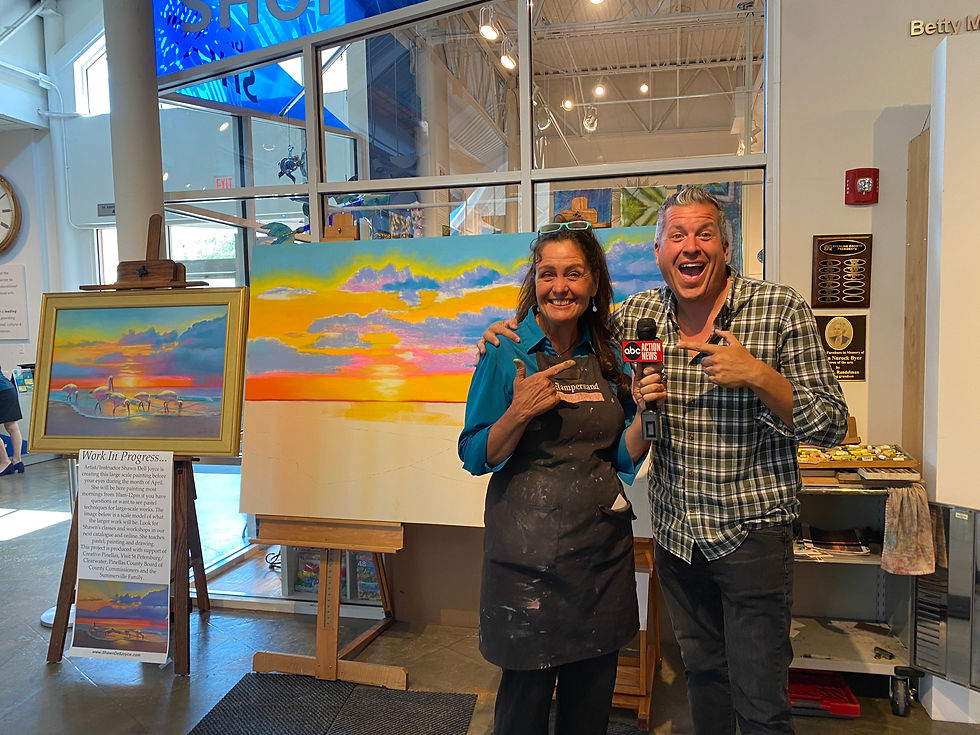The Meaning of it All!
- Shawn Dell Joyce artist

- Apr 11, 2021
- 3 min read
This week I had the opportunity to be interviewed by Eric Rhoads for Plein Air Podcast about the power of art as a tool for social change. During the discussion, the concept of Transcendentalism came up in the context of allegory in the works of the Hudson River School artists, who have greatly influenced me.
What does all that mean?
Transcendentalism simply means that there is more to life than meets the eye. Your painting subject, simply by being painted, transcends reality and becomes vaulted to the sublime by the hand of the artist.
Painters and poets like Emerson, Whitman, and others saw God in all things; Immanence, the concept that the divine is more than the Christian idea, but that God exists in all things in the natural world; trees, rocks, waterfalls, animals.
So what does this have to do with you?
Did you ever think about what motivated you to make that painting? Was it the play of light and shadow, or was it something else, the magnificent experience of light that takes on almost a holy sound as it streams through the trees and illuminates the ground.
In this painting, I felt the presence of the divine in these trees, the way the light beamed down made a sound in my ears like the sound of angels singing (which is the title for this painting), I felt truly alive and present in this moment and hoped to capture that feeling in the painting.

"Sound of Angels Singing" Pastel on Ampersand Pastelbord, 18x24
For me, this is the essence of plein air. We are in a moment that will quickly pass and never happen again. How can we preserve this time and place so that others may experience the sunlit glade?
There is an immediacy about plein air painting where you are immersed in the scene, in this place, in this moment, at this time. When you are able to communicate that to viewers, it resonates at a human level. We cannot help but be touched emotionally by the passion of life.
Every painting tells a story. It has a narrative, whether we are conscious of it or not. I look for the narrative in a scene. The narrative dictates what goes in the painting and what gets edited out. For example, there were power lines in the landscape behind this scene. I felt they did not add to the narrative of the two herons racing to secure the nest before the the approaching storm.

"Racing the Storm" Pastel on Ampersand Pastelbord 24x36
Narratives can be subtle. The more subtle the narrative, the more compelling the story. I fall in love with the narrative, that compels me to paint. This painting may seem like an odd combination for a still life until you read the title. Then you realise that I painted this without power while waiting for a tropical storm to pass over our Florida home.

"Waiting Out the Storm" Pastel on Ampersand Pastelbord 8x10
Narratives can also be allegorical. An allegory is using something symbolically in a painting to stand for a broader topic. For example, this beached and tattered sailboat is an allegory for the human spirit. We may feel tattered and worn by life, yet there is still a proud beauty in even the most beaten-down person. Allegory can be "read into" your subject and is often not a conscious choice by many artists.

One of my influences, Hudson River School founder Thomas Cole spoke of his own painting of Kaaterskill Falls saying "the (waterfall) presents to the mind the beautiful, but incongruous idea of fixedness and motion-a single existence, in which we perceive unceasing change and everlasting duration...It's effortless longevity towers over the comparably meager progress of human civilization."

Thomas Cole "Kaaterskill Falls" oil on canvas 1826
Now much of this is deep thinking which people rarely do in this age of memes and emojis. We tend to take people and scenes at face value and not transcend the mundane. If we take a few minutes to study a work, our works or others, and think about what the audience will take away from this painting now, and in seven generations when there's no one here to explain what the subject is.
Content is important in art. We can carry a message through visual images better than through written word. People will quickly dismiss and overlook a newspaper article, but may take the time to think deeply about a painting they see every day.
If you are interested in hearing my interview on Plein Air Podcast, it should be aired on Wednesday at this link: https://www.outdoorpainter.com/podcast/







Can't wait to hear the podcast! Congratulations on this most prestigious honor to speak to your work and your passion.
Beautifully expressed! This is precisely what drew me to you. 💖 Anne D.
Beautifully observed, reflected on and communicated. I love how you get bolder each year in your artistic expression. 💕
Dearest Shawn, your painting 🧑🎨 titles transcend your message and spirit very well! I so luv the continuity of using the ‘Storm’ in two of your titles...hope you add more to this series!!! Can’t wait to hear your interview and thanks for sharing that link! Talk to you soon! Ali 💜